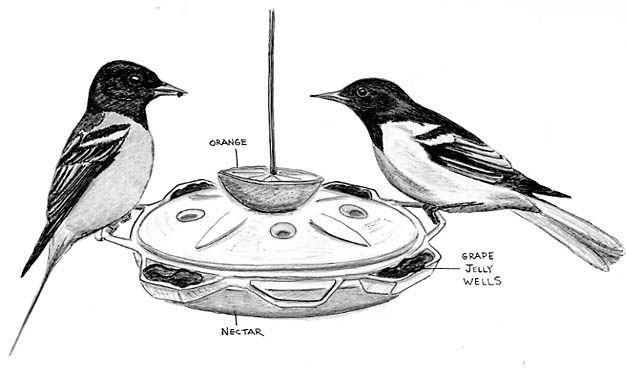
Dear Bird Folks,
We have just opened our house in Chatham (MA) for the summer. One of the first things I did was to set out my bird feeders. Is the birdseed that I had stored in the closet since last fall okay to use? Also, is the formula for hummingbird syrup the same as the formula for orioles?
– Paul, Rutland (and Chatham), MA
I like Rutland, Paul,
Rutland is cool because it’s the geographic center of Massachusetts. That means, unlike when you are on Cape Cod, you can drive in any direction you choose without having to cross a bridge or getting your car filled with saltwater. In Rutland the only direction you have worry about heading is southeast. If you do that you’ll end up in Worcester. That’s not a good thing. My relatives live in Worcester. Enough said.
I never suggest birdseed be stored for long periods. Too many people return, after being away for the winter, to find that some furry creature has found a secret entrance into their closet and has helped itself to the unattended seed. In addition, unless the seed is kept cool, meal moth eggs, which are found in all seed, may hatch out and turn the seed into a webby mess. (When either one of those things happens it somehow becomes my fault; I’m not sure why but over the years I’ve just learned to accept it.) If the old seed hasn’t been eaten, gone buggy or gotten moldy (that’s another one I get blamed for), then it’s most likely safe to feed the birds. However, that doesn’t apply to thistle/niger seed. Those little seeds have a fairly short shelf life and will apparently dry out after a few months. Old thistle isn’t harmful but the birds will spit it out and will hate you. And when that happens you know who will get the blame, don’t you? So for my sake, don’t store seed over the winter. Please. I’m begging you.
About your orioles: Some folks may or may not know that orioles, like hummingbirds, can be attracted to our yards with specially designed nectar feeders. I normally tell people to use the same formula for orioles that they use for hummingbirds (four parts water to one part sugar). I’ve read that a weaker mixture (six parts water to one part sugar) should be used for orioles. That’s fine if it works. Using a bit less sugar will save a few bucks on your sugar bill and will help the orioles keep their slender figures. However, the high number of customers who tell me that they have orioles awkwardly drinking from their hummingbird feeders strongly suggests that the orioles totally dig that four-to-one hummingbird mixture. So, you make the call.
While we are on the topic of orioles I want to mention two other popular methods of attracting them. The tradition of putting put orange halves for orioles has been around since the caveman/cavewoman days. Not only do the birds love the oranges, but there is no need to buy a special feeder, thus no extra expense and nothing to clean. And once the birds have eaten out the inside of the oranges it’s off the compost pile with them (the oranges, not the birds).
In recent years many people have started offering grape jelly and have had tremendous results with it. It turns out that orioles are jelly junkies. They love the stuff. A small dish of grape jelly can be an oriole magnet. That’s the good news. The bad news is that some people have gotten sloppy with their jelly, which is doing the birds serious harm. Several wildlife rehabilitators have told me nasty stories of orioles dying from exposure after their feathers became matted down with gooey jelly. If you offer jelly, place it in small dishes and fill and clean them regularly. Do not, as some boneheads have, put out an open jar of jelly. As the birds dip their heads inside to eat, their feathers come in contact with the sticky sides of the jar. Eventually the birds end up looking like my Aunt Gladys who always uses way too much hair spray; only in this case it can be deadly.
It’s important to note that May is prime time for attracting orioles. That is when thousands of hungry migrating orioles pass through our towns and will readily stop in our backyards if we offer them something. However, as May inevitably turns into June the migration ends and the local orioles get down to the business of raising a family. During this period most people find that they have fewer, if any, orioles coming to their feeders. If you haven’t put out your oranges or feeders yet, you may have missed your best chance to attract orioles. Your next best chance will be later this summer and then, next May.
In conclusion, Paul (“In conclusion”? I feel like I’m ending a term paper), use all of your seed before you close up that Chatham house and head back to the geographic center of Massachusetts. And whatever you mix for hummingbirds is fine for orioles, too. Just don’t wait so long next year. Finally, on your way back to Rutland try to avoid going through Worcester. You might bump into my Aunt Gladys and it will take you weeks to get all that hair spray off you.